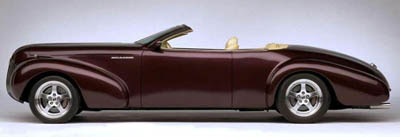The Bugatti Veyron Fbg par Hermès associates Bugatti's technical performance with the expertise of Hermès and its craftsmen. In partnership with Hermès, designer Gabriele Pezzini has married the distinctive Hermès style to the legendary Bugatti Veyron 16.4, magnifying the car's personality.
This remarkable car features an array of exceptional characteristics: the innovative alliance of a technologically advanced engine, delivering 1001 horsepower, with an understated yet uncompromising silhouette reflecting the high performance capacities of state-of-the-art engineering and design, and above all, the pleasure these inspire in every Bugatti owner.
The fascination exerted by this sports coupé, capable of reaching 407 km/h, is due in large part to its unique alliance of the very finest motor-racing technology with comfortable handling for everyday driving.
The 16-cylinder "W" configuration engine is fed by four turbochargers and features 64 valves, generating 1001 horsepower at 6000 rpm. The engine draws on its 8-litre displacement to deliver a maximum torque of 1250 Newton-metres between 2200 and 5500 rpm. With full-time all-wheel drive, the car's phenomenal power produces breath-takingly dynamic handling, with acceleration from 0 to 100 km/h in a mere 2.5 seconds. The Bugatti Veyron 16.4 benefits from aeronautical and aerospace technologies, making it the fastest production car ever made. The car also features a braking system designed to deliver unprecedented powers of deceleration, establishing a new industry benchmark. The carbon-fibre discs provide brake pressure of up to 180 bars, combined with eight-piston monobloc callipers and titanium pistons fitted with fine steel heads and ceramic heat protectors. Apply the brakes at speeds above 200 km/h, and the rear wing acts as an airbrake, positioning itself at an angle of 113 degrees in less than 0.4 seconds, augmenting the Bugatti Veyron's already impressive stopping power. The airbrake increases negative lift at the rear of the car to 300 kg, enhancing the braking torque on the rear axle. At 400 km/h, emergency braking will bring the sports car to a complete halt in less than 10 seconds.
This, the world's most fascinating car, has pushed back the limits of physical engineering to offer a completely new sensation for driver and passenger alike. But it has also adopted a radically different stance to that of other sports cars: its features and finish are sure to impress the most demanding clientele. Hermès and designer Gabriele Pezzini have lavished attention on the interior and exterior of this exceptional car, to create the new Bugatti Veyron 16.4: the Bugatti Veyron Fbg par Hermès.
A HARMONIOUS DESIGN, INSIDE AND OUT
The official name of the highly exclusive Bugatti Veyron Fbg par Hermès refers to the historic Hermès headquarters on the Rue du Faubourg Saint-Honoré, in the heart of Paris's eight arrondissement: the "Fbg" appellation evokes the house's "faubourg" address.
With the Bugatti Veyron Fbg par Hermès, the exacting standards of Émile Hermès and Ettore Bugatti come together for the first time, in an exceptional collaboration: the culmination of their extreme attention to aesthetic and technological quality and performance.
Gabriele Pezzini has reinterpreted Bugatti's traditional two-toned carriage work, fostering a fluid, harmonious transition between the car's exterior and interior design. The colour of the hood extends to the interior of the cockpit, and re-emerges behind, at the level of the rear wing.
As a tribute to the celebrated 1924 Bugatti Type 35, undoubtedly the most famous of all time, thanks to its many successes on the racetrack, the new Bugatti Veyron Fbg par Hermès features eight-spoked wheels in polished aluminium, central butterfly wheel locks branded with the letter H, and air vents around the rims reproducing the characteristics appearance of Hermès saddle-stitching. The horseshoe radiator grille, and the lateral ventilation grilles flanking it, are made from lightweight alloys with a design of interlocking H's evoking the Hermès "signature".
A REFINED FORMAL VOCABULARY
The inner surfaces of the Bugatti Veyron Fbg par Hermès have been designed and sheathed in bull calfskin by the Hermès workshops in Paris. The care and attention to detail observe an extremely refined, minimalist formal vocabulary, reflecting the tradition of the very first Bugattis and the fundamental design principles of the house of Hermès. The door handles echo the fluid forms of handles on Hermès travel bags and luggage.
And the dashboard, traditionally finished in brushed aluminium, is here clad entirely in bull calfskin. Passengers aboard the Bugatti Veyron Fbg par Hermès will find a dashboard glove compartment designed to hold a selection of small travel accessories and a zipped Hermès wallet. Both seats are covered in two-toned bull calfskin, and the panel separating the cockpit from the central rear engine - traditionally made of carbon fibre- is covered in the same fine leather. The leather-lined trunk holds a specially-fitted "Toile H" and leather case, hand-made by the craftmen from the Hermès workshops.

























